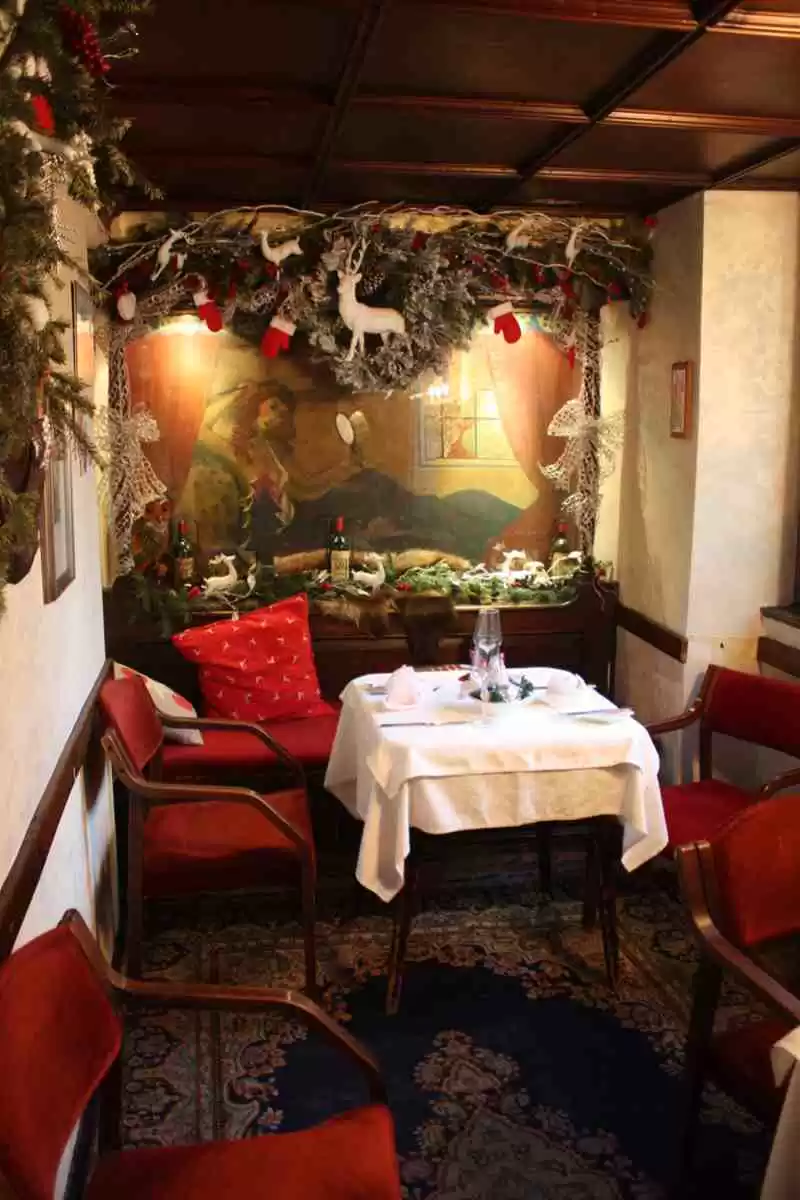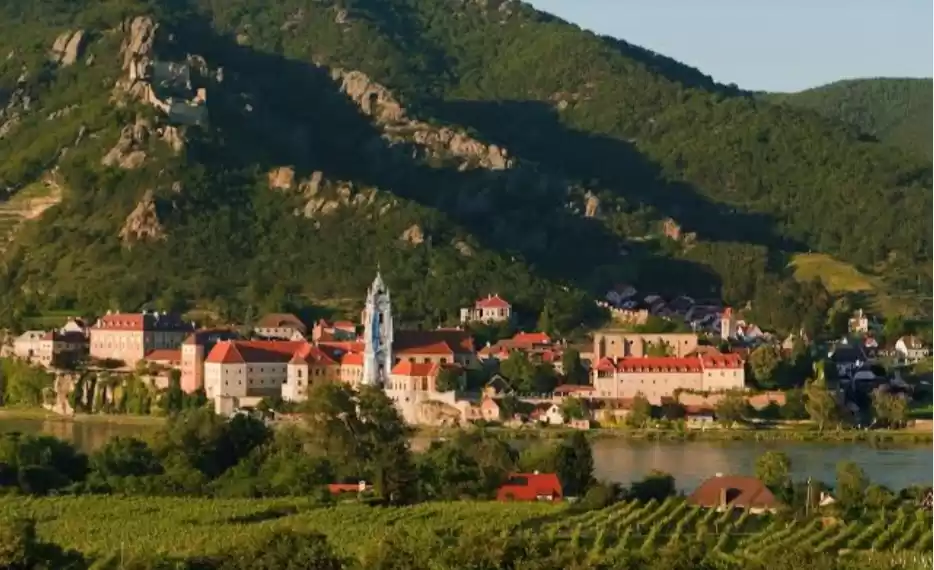
Auf Deutsch lesen
Heavy rain forecasts threaten to spoil our carefully planned excursion to Salzburg, but we send a prayer unto the heavens, and board the train from Munich anyway. The forces that be decide to heed our request, and we are granted a cloudy day instead. Grey skies canopy the Austrian gem wherever we go, but visibility is mercifully good, and thus we proceed on our pursuit of a perfect view in the city that Wolfgang Amadeus Mozart called home.

Salzburg is close to the German border, and only a two-hour train ride away from Munich. Both cities fall under the ambit of the Bayern ticket, and we were thus able to complete our trip in just 32 euros (for both). The Austrian town is known for its panoramic views of the Eastern Alps, its Old Town, which has been designated a UNESCO World Heritage Site, and beautiful hill-top castles and palaces.

As we approach Mirabell Palace & Gardens, we look around at the German names and signs, and remember what a German teacher once told us: Austrians hate to be confused with Germany! Every country likes to have its own identity, after all. And Austria, with its reputation for excellent Sacher Torte, Swarovski crystals, and the world's first postcards, has no dearth of unique achievements. As for Salzburg, the name translates to 'salt castle', owing to the many barges of salt that were transported across the River Salzach in the eighth century. The city also served as the shooting locale for what is one of our all-time favourite films: The Sound of Music.

How could a palace erected in 1606 look so perfect on this overcast spring morning? Mirabell Palace was built as a testimony of prince-archbishop Wolf Dietrich's love for his mistress Salome Alt, and its legacy of romance endures to this day. The Marble Hall, which served as the prince's banquet hall, today hosts dream weddings for those who can afford it. We aren't sure that we can enter the palace, but a friendly English-speaking visitor offers to show us the way to the storied hall. We climb the marvellous Angel Staircase, named thus because of the larger-than-life cherubs resting upon every other inch. The inner chamber of The Marble Hall is not open to the public, but we get a good look at its grand interiors.

Outside, the beautifully landscaped gardens and Fortress Hohensalzburg in the distance make for an arresting frame. In the midst of it all is the Pegasus Fountain, with the flying horse magically mirrored in a surrounding pool. There are four more intricate statues bordering the pool, and we learn later, that they stand for the four elements: fire, earth, air, and water. Yellow, blue, and white blooms create a floral symphony on the vast lawns, and we walk around, admiring the impossible perfection of it all. Here, we find the first ideal view of Salzburg, and in our innocence, we think it is the best.

Across the street from the palace and gardens is Mozart's Wohnhaus, where the maestro lived from 1773 to 1787. However, the composer's birthplace is located on the opposite side of the river. From the banks of the River Salzach, we encounter the second perfect view of the city. The snow-streaked curves of the Alps, the gorgeous edifices and church spires of the Old Town, and the omnipresent Fortress Hohensalzburg line the river from left to right, and we take our time drinking in the sights from one of the bridges.

On the other end of the bridge, we find the gateway to Salzburg's best-kept treasure: the breath-taking Altstadt. At Getreidegasse, a renowned shopping street, we find boutique stores tucked away into shadowy tunnels, and quaint Gasthauses (restaurants) lurking within tiny squares. The stony facade of Mönschsberg towers in the distance. We pass by stores selling Mozartkugeln, irresistible three-layered confections consisting of pistachio marzipan, nougat, and dark chocolate (yes, we had them!).

Once we exit the street, we encounter the triangular St. Blasius Church, and the Spielzeugmuseum (Toy Museum) housed within the arresting courtyard of Burger Spital. Most stunningly, an entire wall is occupied by the cliffs of Mönschsberg. Do such places really exist in this world? The question echoes in our minds again when we chance upon Karajanplatz further down the street. Also known as Horse Pond, this magnificent square is set against the Mönschsberg cliffs, and features a huge horse statue at its centre. The surrounding walls are plastered with 17th century scenes of parade horses showing off their manes and racing prowess.

Old Towns in the heart of most European towns are inevitably picturesque, but we are convinced that Salzburg stands in a league of its own. We visit the Salzburg Cathedral briefly, and while the ornate ceilings and arches are captivating, we are much more entranced by the arcane crypt, where strange stick figures cast eerie shadows on the dimly lit walls. We are now ready to make our way to Salzburg's most famous attraction: The Hohensalzburg Fortress. On the way to the entrance, we pass by Kapitelplatz, dominated by an enormous golden globe with a man standing on top of it. It's a work of art by German sculptor Stephan Balkenhol, and presides over a gigantic chess board on the ground.

So why exactly is the 900-year-old Hohensalzburg Fortress so famous? For one, it is visible from most points in Salzburg, and serves as the city's emblem. And for another, it is one of the largest completely preserved castles in Europe. Built with the aim of protecting the city and its archbishops from foreign invasions, the fortress holds the distinction of never having been captured by hostile forces. We are aware that we can reach the fortress on foot, but decide to take the funicular as we imagine it will treat us to spectacular views (how wrong we are!).

Important: There are four types of tickets available for the fortress. Two are sold at the ticket booth at the bottom: most museums+funicular, or all museums+funicular. Two more are sold at a smaller ticket booth after a short uphill walk: only entry or entry with museum access. The price difference between the first two and the second two is HUGE, and the funicular ride is too short to be worth it. Our recommendation: walk to the second booth and take the museum access ticket if you have enough time on hand.

The funicular shoots up the Festungsberg mountain in a matter of seconds, and we feel a little cheated when we get out. But the view that greets us when we step out on the terrace pushes everything else out of our minds. On the left, the Alps are closer than ever before. Straight ahead, bridges streak across the curving River Salzach, and the city is a glorious study in pastels. Not one building is out of place in the postcard laid out before us, and church spires and ancient domes rise above the mint, sunshine, and peach houses. Here, we find our third perfect view in Salzburg, and we have to say, it outshines the previous two by a wide margin.

We climb a spiraling staircase to enter the sprawling castle courtyard, and walk among the perfectly maintained walls and chapels. Inside, a museum takes us through the fortress's history, while another has marionettes do the story-telling. The latter is entrancing, and we spend a long time watching the puppets enact the Peasants' Revolt of 1525. At the Rainer Regiment Museum, we get a glimpse of the way soldiers looked during World War I, and the weapons they used. There is another terrace higher up at the fortress, and once again, we are unable to tear ourselves away from the scenic mountainous and architectural vistas.

We decide not to take the funicular back down, and instead embark on the Mönschsberg Trail, which takes us through lovely hillside gardens and quiet neighbourhoods, finally leading to the terrace before the Modern Art Museum. Along the way, we chance upon a wonderful view of Hohensalzburg Fortress etched against the Alps, with nothing else vying for the limelight. It's an exemplary frame, and we know we've found our fourth perfect view of Salzburg. Surely, nothing else could rival the scenes we've feasted on thus far? Further views of the city and the mountains beyond offer some competition as we follow the trail, but we feel we've already seen the best.

And then we lay our eyes on the Salzburg panorama that shows up on most web searches: the mountains, the castle, the river, and the city's Old Town all arranged in Godly perfection at the terrace in front of the Modern Art Museum. This has to be THE perfect view of the Austrian wonder. ( In the featured image at the top of this post, you see a zoomed in version of the same photograph.)

Note: If you want to do the trail, take the footpath leading down from the fortress. Ahead of the ticket booth, the road forks into two. Instead of going right towards the Altstadt, take the left, and continue straight. Follow the signboards pointing towards Modern Art Museum.

But Salzburg isn't quite done taking our breaths away. In the fading light of twilight, we make our way to the riverbank, and there, we find the shimmering lights of the city and the Hohensalzburg Fortress reflected upon the lavender mist water. The sky is a mauve-indigo gradient, and to the left, more modern edifices stain the river with gold and royal blue. People say that Vienna, Innsbruck, and Hallstatt are the most beautiful cities in Austria, but how could anything be lovelier than this baroque masterpiece in the lap of Alpine grandeur? If music were a place, it would be Salzburg.
Thoughts? We'd love to hear from you. Leave a comment below, or chat with us on Facebook, Twitter, Instagram, Pinterest, or YouTube.
This blog was originally posted on Trail-stained Fingers.

























